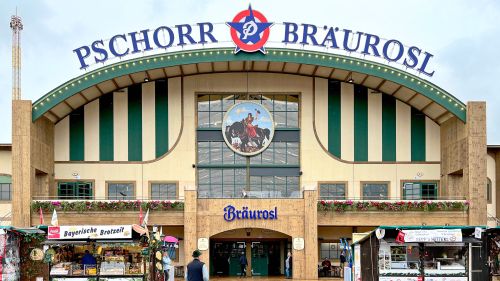Pschorr Bräurosl - Oktoberfest 4.0

The traditional Bräurosl relies on modern automation solutions in the dispensing system.
IO-Link guarantees beer supply in the Munich Oktoberfest marquee
In 1901, the traditional Pschorr Bräurosl marquee already boasted a technical highlight when it was set up for the first time at the Oktoberfest: it was the first marquee there to have electric lighting. More than a century later, in 2011, a beer ring line was installed under the tent. It helped to optimise the supply of festival beer to the tent, from the logistics of nightly deliveries to the desired quality and efficient supply to the individual bars. When the marquee was redesigned in 2019, the Paulaner Brewery Group, to which the Hacker-Pschorr brand belongs, took the opportunity to further optimise this ring line.
To the tap via the ring line
The beer ring line is a central component of the dispensing technology of the Pschorr Bräurosl. It was installed for the first time in 2011 and ran underground below the marquee. From a technical container with three central 28,000-litre beer tanks, it supplies the six tapping points with festival beer. Despite all the advantages, the maintenance of this pipeline always posed challenges for the brewing engineers. Therefore, when redesigning the Pschorr Bräurosl, the brewery decided to move the beer ring line into the marquee itself. It now runs beneath the balcony.
To ensure that the beer arrives at the taps at the ideal temperature of approx. 1°C, a vacuum-insulated line was installed that delivers the beer to the taps in the highest possible quality.
The conception of the dispensing technology in the Bräurosl festival tent was provided by Uwe Daebel, graduate brewing engineer of the Paulaner Brewery Group, who had the opportunity to gather technical experience with similar projects in the past.
Magnetic-inductive volumetric flow sensors accurately detect the beverage quantities at the individual dispensing taps. Other sensors detect various temperature, conductivity and pressure values in the system. All these measured values are used by the festival host to evaluate the quantities while the system is in operation and - very importantly - to forecast the quantities of beer that have to be delivered each night by tanker lorries. This sensor-based quantitative and qualitative monitoring of the beer flow is the only way to provide guests with a beautifully tapped and, above all, fresh festival beer at all times during the 16 to 18 days of the Oktoberfest.
Data management via IO-Link
It quickly became clear to the planners that a powerful data infrastructure was needed to collect the huge amount of sensor data and forward them in bundles to the central controller. The choice fell on ifm electronics IO-Link technology. Since this technology was still new to the commissioned company, demand-oriented training was provided by the automation specialist ifm early on in the project. During the implementation phase, ifm also provided quick and personal support for any questions that arose.
The sophisticated technology processes over a hundred measured values from sensors via several decentralised IO-Link master modules and transmits them via Profinet to a central PLC. Thus, this PLC coordinates all beverage supply processes. At the same time, all relevant data is uploaded to a cloud and analysed in real time. Process deviations will immediately be indicated, so that countermeasures can be taken in good time. This ensures maximum reliability of supply and quality.

Flow sensors accurately monitor the flow rate of each individual tap.
IO-Link as a manufacturer-independent standard
It is possible to connect up to 8 sensors and actuators to each of ifms AL1403 IO-Link masters. Binary signals can also be forwarded via the I/O ports of these modules, which has further simplified installation in the Bräurosl.
All in all, IO-Link technology is the ideal backbone for effective operation of the complex Bräurosl technology. The big benefit: Not only ifm sensors, but also sensors from other manufacturers can be connected without any problems. With the ifm software moneo configure SA, all connected sensors can be configured and diagnosed from a central location via remote access. This not only enables easy setup, but also quick diagnostics in the event of a fault.
The hygienically designed IO-Link field modules of the "Food" series are designed for use in harsh conditions. They are positioned exactly where the sensor data is generated, both in the tent itself and directly in the refrigerated containers where the non-alcoholic drinks are stored in barrels.
Decentralised installation has reduced the installation complexity significantly. This also eliminates common hurdles such as issues with potentials or interference with analogue values. Especially in large temporary installations with networks of several 100 metres, the sensor-related signal bundling offers invaluable advantages compared to conventional separate wiring of all sensors.

Decentralised IO-Link masters collect the various sensor signals and transmit them in bundles via Profinet to the central controller.
Conclusion
Thanks to ifms IO-Link technology, it is much easier and faster to disassemble the complex technology again when the Oktoberfest is over and to store it until the next time it is used while ensuring it will work reliably again. Moreover, changes or extensions can be easily implemented. The IoT interfaces integrated in the IO-Link masters also enable data analysis and data transfer directly to the IT or cloud, bypassing the PLC.
For the commissioned company, using IO-Link constituted a significant relief. One thing is certain: The advantages of IO-Link will be indispensable in further projects.
